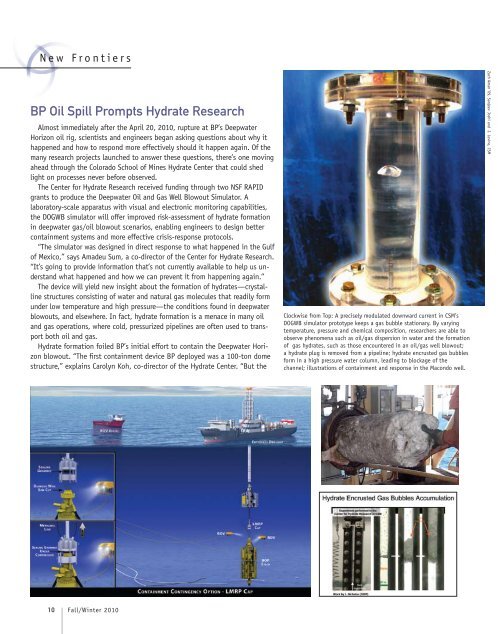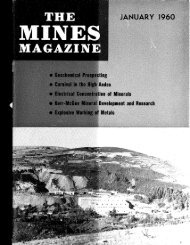Mines Magazine Turns 100 - the Timothy and Bernadette Marquez ...
Mines Magazine Turns 100 - the Timothy and Bernadette Marquez ...
Mines Magazine Turns 100 - the Timothy and Bernadette Marquez ...
- No tags were found...
Create successful ePaper yourself
Turn your PDF publications into a flip-book with our unique Google optimized e-Paper software.
New FrontiersBP Oil Spill Prompts Hydrate ResearchAlmost immediately after <strong>the</strong> April 20, 2010, rupture at BP’s DeepwaterHorizon oil rig, scientists <strong>and</strong> engineers began asking questions about why ithappened <strong>and</strong> how to respond more effectively should it happen again. Of <strong>the</strong>many research projects launched to answer <strong>the</strong>se questions, <strong>the</strong>re’s one movingahead through <strong>the</strong> Colorado School of <strong>Mines</strong> Hydrate Center that could shedlight on processes never before observed.The Center for Hydrate Research received funding through two NSF RAPIDgrants to produce <strong>the</strong> Deepwater Oil <strong>and</strong> Gas Well Blowout Simulator. Alaboratory-scale apparatus with visual <strong>and</strong> electronic monitoring capabilities,<strong>the</strong> DOGWB simulator will offer improved risk-assessment of hydrate formationin deepwater gas/oil blowout scenarios, enabling engineers to design bettercontainment systems <strong>and</strong> more effective crisis-response protocols.“The simulator was designed in direct response to what happened in <strong>the</strong> Gulfof Mexico,” says Amadeu Sum, a co-director of <strong>the</strong> Center for Hydrate Research.“It’s going to provide information that’s not currently available to help us underst<strong>and</strong>what happened <strong>and</strong> how we can prevent it from happening again.”The device will yield new insight about <strong>the</strong> formation of hydrates—crystallinestructures consisting of water <strong>and</strong> natural gas molecules that readily formunder low temperature <strong>and</strong> high pressure—<strong>the</strong> conditions found in deepwaterblowouts, <strong>and</strong> elsewhere. In fact, hydrate formation is a menace in many oil<strong>and</strong> gas operations, where cold, pressurized pipelines are often used to transportboth oil <strong>and</strong> gas.Hydrate formation foiled BP’s initial effort to contain <strong>the</strong> Deepwater Horizonblowout. “The first containment device BP deployed was a <strong>100</strong>-ton domestructure,” explains Carolyn Koh, co-director of <strong>the</strong> Hydrate Center. “But <strong>the</strong>Clockwise from Top: A precisely modulated downward current in CSM’sDOGWB simulator prototype keeps a gas bubble stationary. By varyingtemperature, pressure <strong>and</strong> chemical composition, researchers are able toobserve phenomena such as oil/gas dispersion in water <strong>and</strong> <strong>the</strong> formationof gas hydrates, such as those encountered in an oil/gas well blowout;a hydrate plug is removed from a pipeline; hydrate encrusted gas bubblesform in a high pressure water column, leading to blockage of <strong>the</strong>channel; illustrations of containment <strong>and</strong> response in <strong>the</strong> Macondo well.Zach Aman ’09, Sanjeev Joshi <strong>and</strong> J. Levine, CSM10 Fall/Winter 2010

















